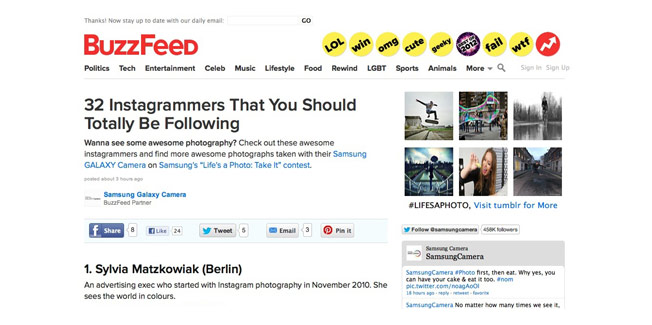Madyson Lewellyn
m.lewellyn13@gmail.com
There's no question that native advertisements are used to deceive and misdirect readers in consumer media.
In Digiday article "Native Advertising is Bad News," Ben Kunz warns "if publishers and marketers aren't careful, they are going to poison the well of digital as communications by breaking consumer trust." Kunz continues on to describe a plausible means as to why publishers are becoming so eager to make native ads apart of their platforms -- stating it is all a cycle of making profit and charging higher ad rates.
Kunz breaks down native ads into a a spectrum of annoyance that is classified into three categories: The Fame, The Insertion and The Misdirection.
The Fame category is the surface level of annoyance that is the least harmful. It can be spotted quickly by the average reader, as it usually comes with an intro or ending note that is sponsored directly "sponsored by a marketer" with "no real issues."
The Insertion category is what is frequently seen on publishers such as The Huffington Post and The Atlantic. This level of annoyance is where native ads begin to confuse readers, as they come with content that is produced by marketers that systematically mirrors the publication's actual stories and videos.
 |
| Source: Buzzfeed |
The Misdirection category is where the deceptions gets downright insidious. In this level, paid content is designed for deception and used to misdirect all readers. The native ads in this category show little to no difference between the publisher's regular content and the paid ad content.
Economically, it makes sense. Ethically, it is becoming atrocious.
If publishers continue to poison the consumer media with more and more native ads, the overall trust with readers will soon dwindle to nothing. As journalism continues to evolve into the digital world, native ads are ultimately halting it's overall growth that is reversing a sense of trust and transparency within the readership.
If publications want to continue featuring paid content and keep the viewership afloat, there must be full disclosure and labeling of promoted brand content as such.
In her article "The Good and Evil of Native Advertising," Joline Buscemi reveals a means to both sides. She details the good as a reader stumbling upon an article who may be annoyed when noticing it is paid content, but satisfied with the content that came along with it. Likewise, Buscemi describes the evil reason why people hate native advertising because "it can make them feel cheated, lied to and taken advantage of."
I like your comment that you quoted from the first article stating that native advertisements are used to deceive and misdirect readers in consumer media. I also agree with the comment you quoted from the article stating "if publishers and marketers aren't careful, they are going to poison the well of digital as communications by breaking consumer trust."
ReplyDelete